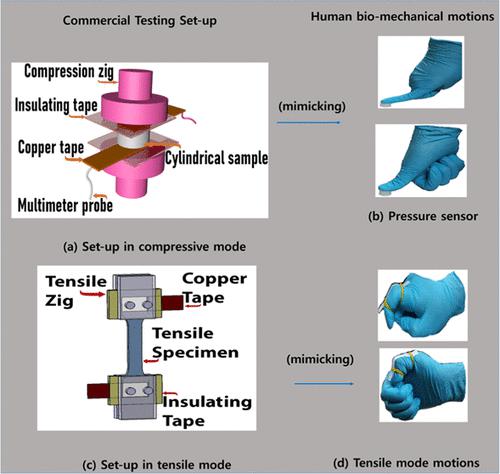当前位置:
X-MOL 学术
›
ACS Appl. Electron. Mater.
›
论文详情
Our official English website, www.x-mol.net, welcomes your feedback! (Note: you will need to create a separate account there.)
Mimicking Self-Powered Piezoelectric Energy-Generating Behavior in Silicone Rubber Composites under Compressive and Tensile Strains
ACS Applied Electronic Materials ( IF 4.7 ) Pub Date : 2024-03-04 , DOI: 10.1021/acsaelm.3c01536 Vineet Kumar 1 , Md. Najib Alam 1 , Manesh A. Yewale 1 , Dong-Joo Lee 1 , Sang Shin Park 1
ACS Applied Electronic Materials ( IF 4.7 ) Pub Date : 2024-03-04 , DOI: 10.1021/acsaelm.3c01536 Vineet Kumar 1 , Md. Najib Alam 1 , Manesh A. Yewale 1 , Dong-Joo Lee 1 , Sang Shin Park 1
Affiliation

|
This study used a multifunctional and versatile silicone rubber, which can be vulcanized at room temperature, as the stretchable elastomeric matrix. Then, reinforcing fillers such as molybdenum disulfide (MoS2), diatomaceous earth (D.E.), and hybrids were used. Our results showed that the compressive modulus and tensile strength are improved after the addition of these reinforcing fillers. For example, the compressive modulus of the control sample was 1.93 MPa, and it increased to 6.1 MPa (D.E.), 2.47 MPa (MoS2), and 3.3 MPa for their hybrid at 20 phr. Similarly, the tensile strength of the control sample was 0.52 MPa, and it increased to 1.42 MPa (D.E.), 0.87 MPa (MoS2), and 0.83 MPa for their hybrid at 20 phr. We also conducted energy-harvesting experiments and found that the voltage output was higher for the compressive mode sets by 8–11 times than for the tensile mode sets, even under similar strain magnitudes. For instance, the output voltage at 30% strain for MoS2-filled composites was approximately 0.65 mV for compressive mode and 0.06 mV for tensile mode. Moreover, the energy harvesting was higher for hybrid-filled systems due to the synergistic effect than for D.E. or MoS2 as the only filler in the composites. For example, the output voltage was 1.22 mV (MoS2), 0.37 mV (D.E.), and 5.5 mV (hybrid) at 15 phr loading. Similarly, in real-time monitoring, compressive mode generated a higher voltage than tensile mode. Overall, the promising voltage output performance developed in the present work shows great potential for the future of smart health monitoring.
中文翻译:

模拟硅橡胶复合材料在压缩和拉伸应变下的自供电压电发电行为
本研究使用可在室温下硫化的多功能、多用途硅橡胶作为可拉伸弹性体基质。然后,使用增强填料,例如二硫化钼(MoS 2)、硅藻土(DE)和混合物。我们的结果表明,添加这些增强填料后,压缩模量和拉伸强度得到改善。例如,对照样品的压缩模量为 1.93 MPa,在20 phr 的混合物中,压缩模量增加至 6.1 MPa (DE)、2.47 MPa (MoS 2 ) 和 3.3 MPa。同样,对照样品的拉伸强度为 0.52 MPa,在 20 phr 的混合量下,拉伸强度增加至 1.42 MPa (DE)、0.87 MPa (MoS 2 ) 和 0.83 MPa。我们还进行了能量收集实验,发现即使在相似的应变大小下,压缩模式组的电压输出比拉伸模式组高 8-11 倍。例如,MoS 2填充复合材料在30%应变下的输出电压在压缩模式下约为0.65 mV,在拉伸模式下约为0.06 mV。此外,由于协同效应,混合填充系统的能量收集比复合材料中唯一填料DE 或 MoS 2更高。例如,在 15 份负载下,输出电压为 1.22 mV (MoS 2 )、0.37 mV (DE) 和 5.5 mV(混合)。同样,在实时监测中,压缩模式产生的电压高于拉伸模式。总体而言,目前工作中开发的有前景的电压输出性能显示了智能健康监测未来的巨大潜力。
更新日期:2024-03-04
中文翻译:

模拟硅橡胶复合材料在压缩和拉伸应变下的自供电压电发电行为
本研究使用可在室温下硫化的多功能、多用途硅橡胶作为可拉伸弹性体基质。然后,使用增强填料,例如二硫化钼(MoS 2)、硅藻土(DE)和混合物。我们的结果表明,添加这些增强填料后,压缩模量和拉伸强度得到改善。例如,对照样品的压缩模量为 1.93 MPa,在20 phr 的混合物中,压缩模量增加至 6.1 MPa (DE)、2.47 MPa (MoS 2 ) 和 3.3 MPa。同样,对照样品的拉伸强度为 0.52 MPa,在 20 phr 的混合量下,拉伸强度增加至 1.42 MPa (DE)、0.87 MPa (MoS 2 ) 和 0.83 MPa。我们还进行了能量收集实验,发现即使在相似的应变大小下,压缩模式组的电压输出比拉伸模式组高 8-11 倍。例如,MoS 2填充复合材料在30%应变下的输出电压在压缩模式下约为0.65 mV,在拉伸模式下约为0.06 mV。此外,由于协同效应,混合填充系统的能量收集比复合材料中唯一填料DE 或 MoS 2更高。例如,在 15 份负载下,输出电压为 1.22 mV (MoS 2 )、0.37 mV (DE) 和 5.5 mV(混合)。同样,在实时监测中,压缩模式产生的电压高于拉伸模式。总体而言,目前工作中开发的有前景的电压输出性能显示了智能健康监测未来的巨大潜力。



























 京公网安备 11010802027423号
京公网安备 11010802027423号